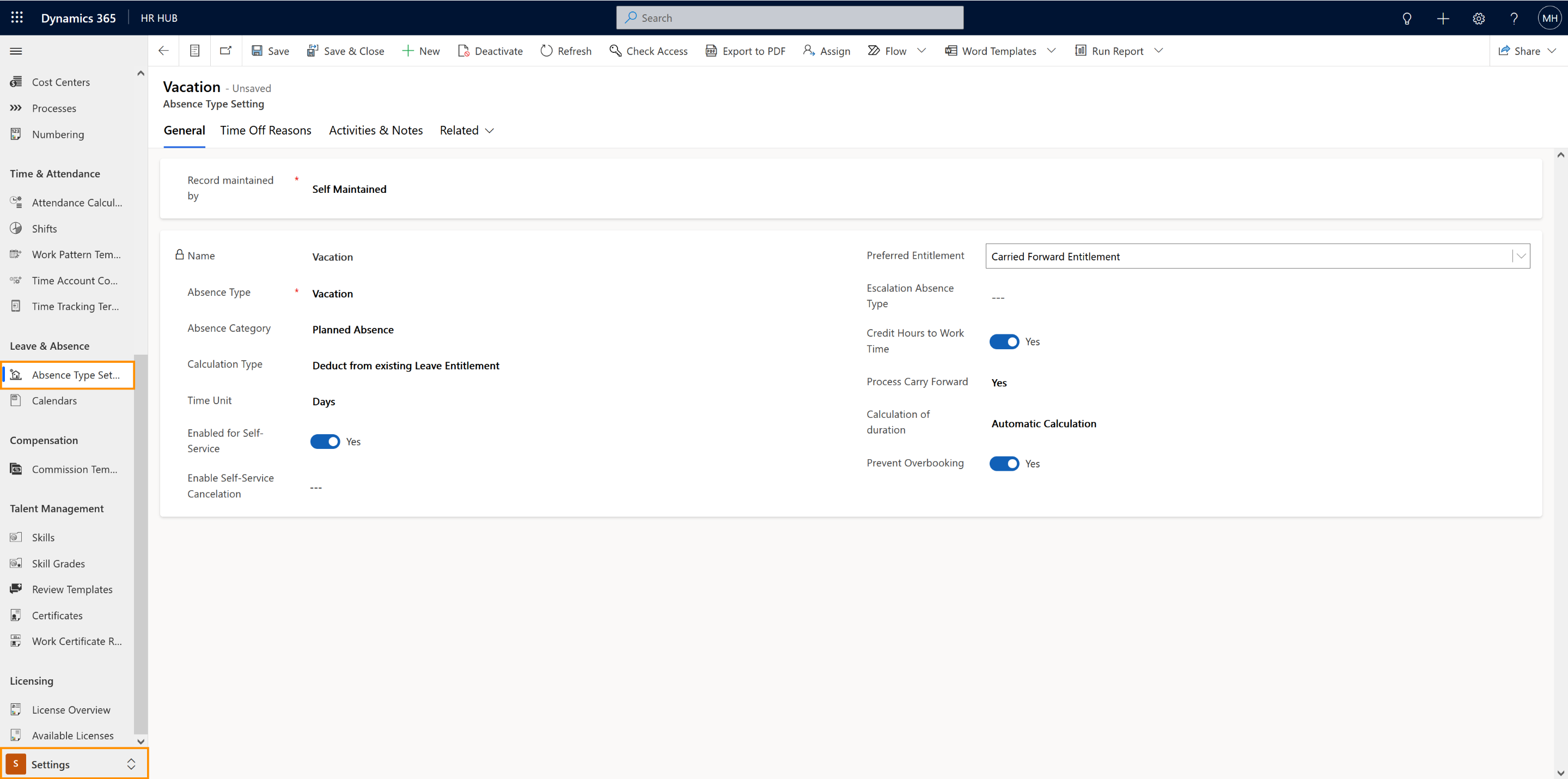How to configure types of absence
Objective
This page will explain how to maintain and configure basic settings for the absence types within the solution. This will ensure the standard procedure of how the system treats different absence types and follows your organization's preferred standard.
Process
HR Manager
Configure the basic settings
Automated process
Use those settings to properly calculate the leaves
Employee
Ability to request leave
Click Through
- Start in HR HUB
- Go to Settings
- Select Absence Type Settings
- Select one type of absence and open it
- Change the "Record maintained by"-field to self-maintained
- Edit the entries according to your standards
- You can find more information on every setting below
- Save
- Repeat this for all Absence Types you wish to use
Configuration Details
- The fields will be locked until you change the "Record maintained by" field from Solution Provider to Self-Maintained
- You can choose between two types of absence categories, Planned and Ad-hoc
- If the option "Credit Hours to Work Time" is set to yes, the different absence categories affect at what point in time the absent hours/days are credited to work time
- Planned absences are credited as soon as they are approved
- Ad-hoc absences are credited as soon as they are created and stay credited as long as they aren't canceled or rejected
- If you don't fill anything out here, the system will use Planned Absence as a default setting.
- Calculation Type:
- Select 'Deduct from existing Leave Entitlement' for absence types that employees receive an entitlement for, e.g. Vacation
- Select 'Create negative Leave Entitlement' for all the other absence types where employees usually don't have entitlements, e.g. work accidents
- When the absence type might have more than 20 leave entitlements per year per employee, we recommend setting this configuration to 'Create negative Leave Entitlement' to ensure the best performance of the system
- If you don't fill anything out here, the system will use Deduct from existing Entitlement as a default setting
- Time Unit: Select whether this absence type is calculated in hours or days
- Enable for Self-Service: Select whether this absence type is available for employee self-service. By default, only vacation is available for self-service.
- If you enable Self-Service for vacation, Employees can create leave requests in the system for themselves
- Enable Self-Service Cancelation: Select whether this absence type can be cancelled by the employee who requested it in Employee Self-Service. This field is only visible when this absence type was selected for Self-Service.
- Preferred Entitlement: Select which Leave Entitlements are consumed first:
- If you select Carried Forward Entitlements, entitlements from the last period (e.g. last year) are consumed first
- If you select New Entitlements, entitlements from the current period are consumed first
- If you don't fill out anything here, the system will use New Entitlements as a default setting
- Escalation Absence Type: Optionally, select the absence type whose entitlement is used to escalate exceeding absences. The Time Units of both absence types must be the same.
- For example, if you use Vacation as an Escalation Absence Type for Sick Days, the employee's sick leave days will be deducted from their vacation leave entitlement after their sick leave entitlement has been used up.
- Credit Hours to Work Time: Select whether the absence time is counted as work time. For example, for vacation (paid leave), set this to Yes.
- Process Carry Forward: Decide whether remaining leave entitlements are processed or ignored. All Absence Types that should be carried forward to the following year need to be set to "Process Carry Forward = Yes".
- Calculation of duration: Select whether the absence duration is calculated automatically or the employee is allowed to enter the duration manually.
- The manual entry of hours could for example be used to enter 1 hour of overtime
- The minimal amount of automatically calculated leave is half a day.
- Prevent Overbooking:
- If set to yes, the employees can only request leave when they have sufficient entitlement for that leave period
- If set to no, the employees can request leave, even if they don't have sufficient leave entitlements for that leave period
Recommendations
- We recommend that you don't create a new type of absence on your own, because there are many connections between different records.
Instead, we encourage you to edit the ones already provided out-of-the-box to suit your company's policies. - Setting the records to Self-Maintained will keep your Absence Type settings from being overwritten by system updates.
Result
Here, you can see an example of a filled-out Absence Type setting (in this case, vacation).
This configuration will now be used by the system whenever a leave request is created.
This configuration will now be used by the system whenever a leave request is created.
Tips & Tricks
If you were not able to configure Absence Type Settings as described above, please check the following:
- You are HR Manager
- You have a valid license assigned to you
